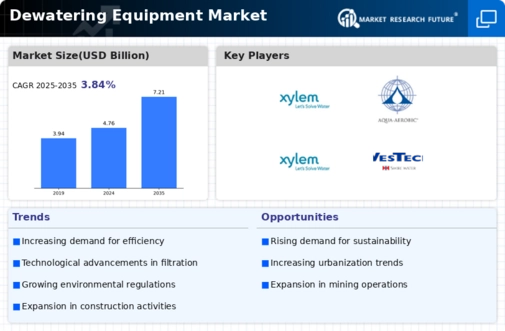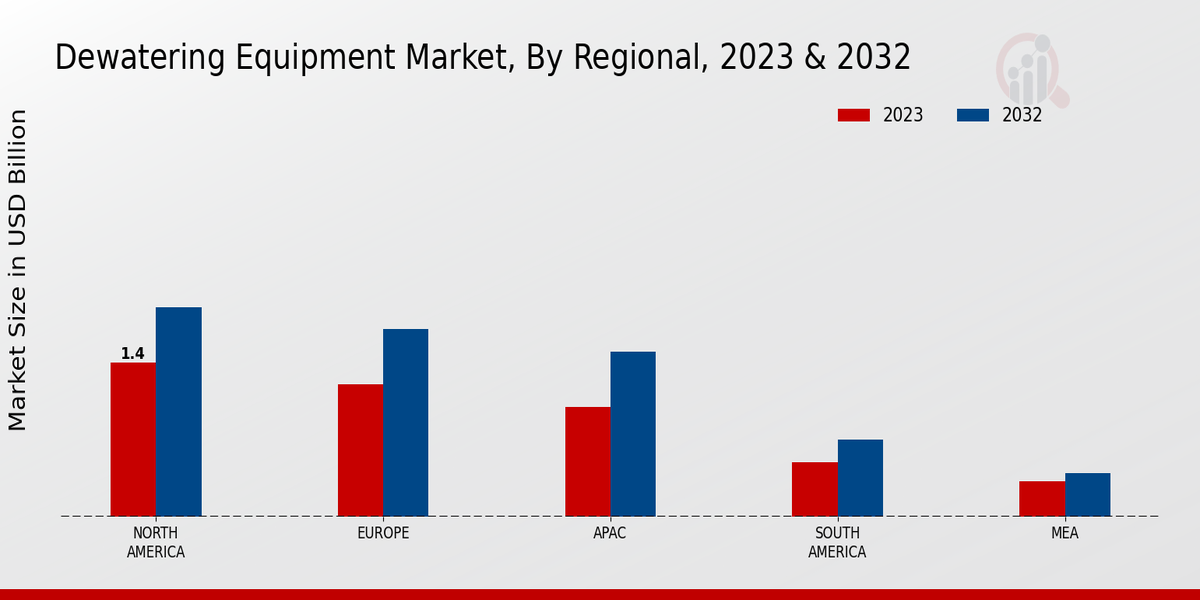Market Growth Projections
The Global Dewatering Equipment Market Industry is poised for substantial growth, with projections indicating a market value of 4.76 USD Billion in 2024 and an anticipated increase to 7.21 USD Billion by 2035. This growth trajectory reflects a compound annual growth rate (CAGR) of 3.84% from 2025 to 2035. Such figures underscore the increasing reliance on dewatering technologies across various sectors, including construction, mining, and agriculture. The market's expansion is likely driven by technological advancements, regulatory pressures, and the growing need for efficient water management solutions.
Technological Advancements
Technological innovations play a pivotal role in shaping the Global Dewatering Equipment Market Industry. The introduction of advanced dewatering technologies, such as belt filter presses and centrifuges, enhances efficiency and reduces operational costs. These innovations allow for better separation of solids and liquids, which is crucial for industries like mining and construction. As companies strive for operational excellence, the adoption of these technologies is likely to increase. The anticipated CAGR of 3.84% from 2025 to 2035 indicates a robust growth trajectory, driven by the continuous evolution of dewatering equipment that meets the demands of various sectors.
Rising Construction Activities
The Global Dewatering Equipment Market Industry benefits from the surge in construction activities worldwide. As urban areas expand, the demand for dewatering solutions in construction sites increases to manage groundwater levels and prevent flooding. In regions like Asia-Pacific, significant investments in infrastructure projects contribute to this trend. The market is expected to grow, with projections indicating a value of 7.21 USD Billion by 2035. This growth is likely supported by the need for efficient site management and adherence to safety regulations, which necessitate the use of advanced dewatering technologies to ensure smooth construction processes.
Environmental Regulations and Compliance
The Global Dewatering Equipment Market Industry is significantly influenced by stringent environmental regulations aimed at reducing pollution and promoting sustainable practices. Governments worldwide are enforcing laws that require industries to manage waste effectively, leading to an increased demand for dewatering solutions. For example, regulations on sludge disposal and wastewater treatment compel industries to invest in advanced dewatering technologies. This trend is expected to sustain market growth as companies prioritize compliance to avoid penalties and enhance their environmental footprint. The focus on sustainability is likely to drive further innovation in dewatering equipment, aligning with global environmental goals.
Increasing Demand for Wastewater Treatment
The Global Dewatering Equipment Market Industry is experiencing heightened demand due to the growing need for effective wastewater treatment solutions. As urbanization accelerates, municipalities are investing in infrastructure to manage wastewater efficiently. For instance, the global market is projected to reach 4.76 USD Billion in 2024, driven by stringent regulations on wastewater discharge. This trend is particularly evident in developing countries where rapid industrialization necessitates advanced dewatering technologies. The focus on sustainable practices further propels the adoption of dewatering equipment, as industries seek to minimize environmental impact while complying with regulatory standards.
Agricultural Expansion and Water Management
The Global Dewatering Equipment Market Industry is also driven by the expansion of agricultural activities and the need for effective water management. As agriculture becomes increasingly intensive, the demand for dewatering solutions to manage excess water in fields rises. This is particularly relevant in regions prone to flooding or with high groundwater levels. The agricultural sector's reliance on dewatering equipment for irrigation and land preparation is likely to grow, contributing to market expansion. The integration of dewatering technologies in agriculture supports sustainable practices, ensuring optimal water usage while enhancing crop yields.















